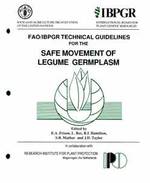Germplasm collections
 |
Handbooks for Genebanks No. 6:
A guide to effective management of germplasm collections (1.4MB)
The initiative to bring experts together to discuss the consequences of changes in the roles and responsibilities of genebanks led to this publication. It is hopes that the ideas put forward lead to more critical balanced and creative approach towards genebank operations on the part of genebank curators worldwide. It is also hoped that decisions concerning concepts and strategies that have been or will be made at the institutional and national level on the conservation and use of plant genetic resources will be made easier by this publication. Genebank are encouraged to share their experiences through all means of communication. The reader is kindly invited to provide IPGRI with any comments or suggestions on the current text that would contribute to more effective and efficient conservation and thereby assist in the generation of a solid knowledge base for genebank management.
Authors: Engels, J.M.M.; Visser, L. (eds.)
Publication Year: 2003
Pages: 174
ISBN-10: 92-9043-582-8
ISBN-13: 978-92-9043-582-2
Language: English
 |
IPGRI Technical Bulletin No. 3: Core Collections of plant genetic resources (0.9MB)
Genebanks around the world hold collections of the genetic resources of crop plants for long-term conservation and for ease of access by plant breeders, researchers and other users. Perceiving that the large size of some collections could deter use, Frankel (1984) proposed that a limited or "core collection" could be established from an existing collection. With minimum similarity between its entries the core collection is of limited size and chosen to represent the genetic diversity of a large collection, a crop, a wild species or group of species. It does not replace the existing collection or material from which it is obtained. Core collections have become accepted as efficient tools for improving conservation and use of collections. The Global Plan of Action for the Conservation and Sustainable Utilization of Plant Genetic Resources for Food and Agriculture (FAO 1996) recommends core collection development as one of the activities needed to improve use of plant genetic resources. This technical bulletin sets out the procedures that can be used to establish, manage and use a core collection, drawing on the accumulated experience so far.
Authors: van Hintum, Th.J.L.; Brown, A.H.D.; Spillane, C.; Hodgkin, T.
Publication Year: 2000
Pages: 48
ISBN-10: 92-9043-454-6
ISBN-13: 978-92-9043-454-2
Language: English
 |
IPGRI Technical Bulletin No. 5: Accession management trials of genetic resources collections (0.7MB)
The publication is aimed at curators and other genebank staff. It is meant to be a discussion guide, to provide ideas and suggestions on how management procedures can be improved, and to point to possible implications of a given management procedure. It does not aim to provide a definitive theory on composing genebank collections or on the management of accessions, nor does it attempt to provide a complete overview of possible approaches and procedures. The reader is invited to give feedback to IPGRI (comments, additions, alternative approaches, etc.) on any aspect of the contents, and thus contribute to the discussion started with this publication.
Authors: Sackville Hamilton, N.R.; Engels, J.M.M.; van Hintum, Th.J.L.; Koo, B.; Smale, B.
Publication Year: 2002
Pages: 66
ISBN-10: 92-9043-516-X
ISBN-13: 978-92-9043-516-7
Language: English
 |
Access and management of germplasm collections: Core collections for today and tomorrow (available as HTML version)
Core collections offer a tool to improve access and management of germplasmcollections, and therefore are of great interest to those who use and manage plant genetic resources. Over the past few years, experience with core collection has increased as cores for many crops have been developed. The purpose of this publication is to review the current status of core collections and present examples of core development and utilization. The authors were chosen to report on a wide range of views and experiences with core collections, but the examples were not chosen based on desigantion by crop. We find few cores have actually been developed for the major seed crops. Ironically, the use of core collections to improve access to large, unwieldy collections, originally envisioned by Sir Otto Frankel, has not yet come to fruition. Certeinly the complexity and volume of data needed to develop a core collection for large collections can be daunting, but possible approaches and opportunity are described.
Authors: Johnson, R.C.; Hodgkin, T. (eds.)
Publication Year: 1999
Pages: 81
ISBN-10: 92-9043-424-4
ISBN-13: 978-92-9043-424-5
Language: English
 |
FAO / IBPGR Technical Guidelines for the Safe Movement of Legume Germplasm: A methodological model for ecogeographic surveys of crops (0.3MB)
These guidelines are divided into 2 parts. The first makes general recommendations on how best to move grain and fodder legume germplasm and breeding material. The second part covers the important viral, bacterial and fungal diseases of quarantine concern. The information given on any particular pathogen concentrates on those aspects most relevant to quarantine. An appendix lists Latin and vernacular (English, French, Spanish, German and other) names of major legume species. (Abstract © CAB ABSTRACTS, CAB International)
Authors: Frison, E.A.; Bos, L.; Hamilton, R.I.; Mathur, S.B.; Taylor, J.D. (eds.)
Publication Year: 1990
Pages: 88
ISBN-10: 92-9043-150-4
ISBN-13: 978-92-9043-150-3
Language: English
Comments
- No comments found





Leave your comments
Post comment as a guest